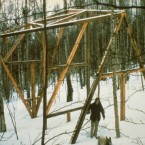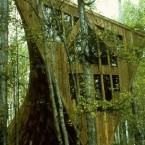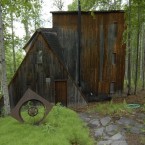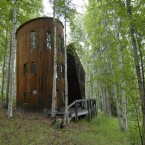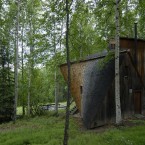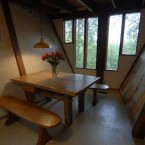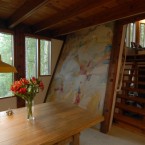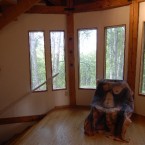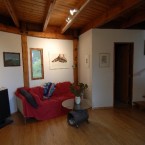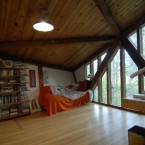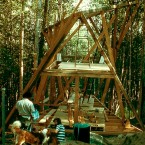-

Timber frame for Mark's House in 1973: a girl friend, a dog and the start of a house, a very good year. ■
-
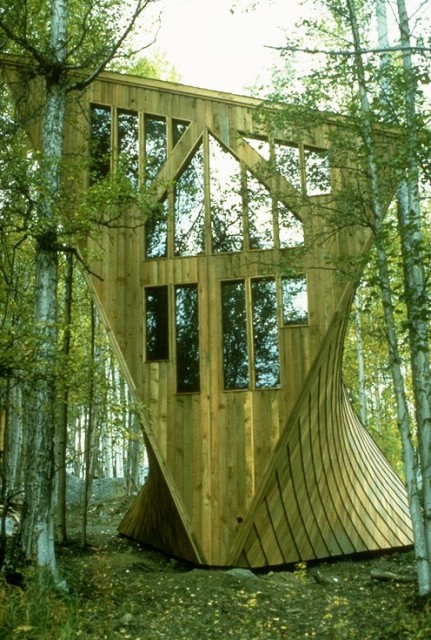
Mark's House in the hills north of Fairbanks, white spruce timber frame, cedar channel siding, cedar shingles, comp roofing, 1974 ■: I was born in Fairbanks in 1947 and, I thought, grew up like most everyone else in rural America. Without a frame of reference it seemed to me that Fairbanks was a typical small town except it got a little cold in the winter. The fact that it was 375 miles to next town did make it seem a little isolated but it wasn't until I began traveling outside in the mid 60's that I realized that Fairbanks was a unique place indeed.
-

Fairbanks was surrounded by real and raw wilderness and was the perfect breeding ground for the 'man against nature' challenge. I was taught and grew to appreciate the cold and isolation and my birthplace had given me a jump start. I knew a lot about the cold and still remember how satisfying it was to dress and work comfortably at 40 below. ■
-
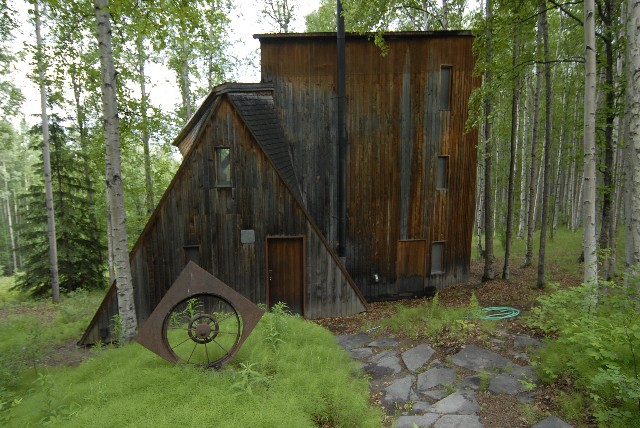
Growing up I often visited friends that lived in the hills around Fairbanks and so early on understood the winter advantages of living on a south facing hill. In addition to more sunlight, there is a winter phenomenon of temperature inversion or stratification with colder temperatures lower in the valleys and warmer higher in the hills. My friends, all children of impressively intrepid parents, lived with hauled water and outhouses, had driveways (and streets) that went unplowed in the winter. To me this lack of facility was a small price to pay for the occasional few hours of a blindingly sunny winter's day that was 20 to 40 degrees warmer than the dark and ice-foggy valley of town where I had to live. ■
-
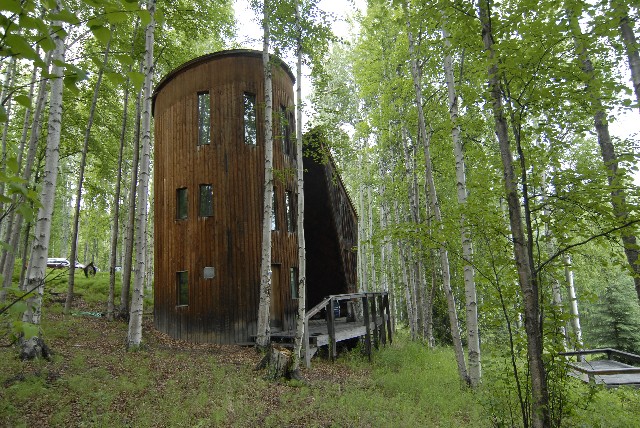
With the perspective of my late teens I decided that Fairbanks was a frontier town with serious climatic and economic challenges. These disadvantages had, I thought, successfully eliminated nearly all of the joy from Alaskan architecture. The owner/builders that imaginatively made do with they had to build with is another story. For everyone else it was difficult and expensive enough to build boxes. The prevailing attitude was that God himself would be happy living in one. ■
-
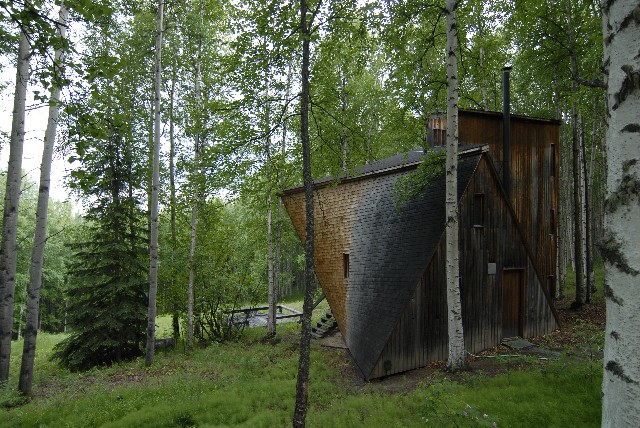
I of course thought this was a glaring and offensive esthetic error. Worse yet, I was convinced that my experience of living through many long dark winters in uninspired buildings had left me somehow damaged. I worried about the gene pool. ■
-
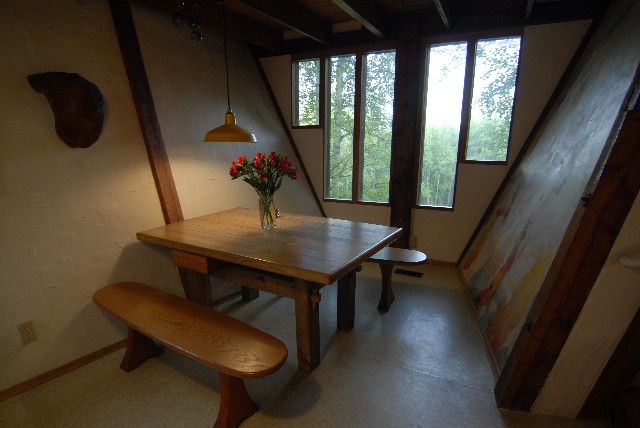
By my mid 20's I had worked construction for a few years, bought a chain saw and a pickup. This little bit of work experience had, of course, taught me everything I needed to know about house building in Alaska. I bought 5 acres of sweet south slope land and began by chain-sawing myself a long driveway. I was nearly ready for the challenge of correcting Alaskan architecture, and also to get out of town. ■
-
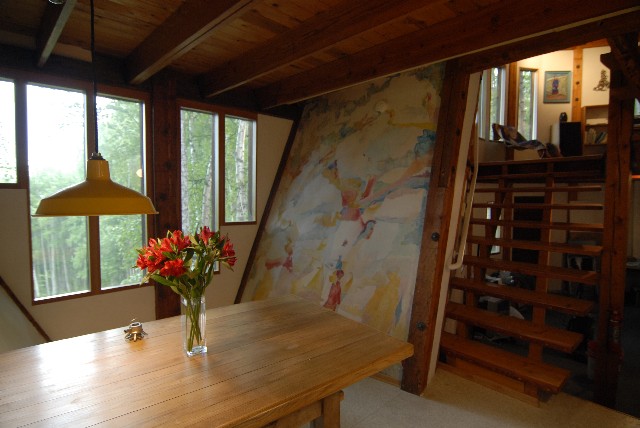
This was the early 70's and so a lot of my friends were also building houses in the woods. We were all pumped up with many of the same idealistic attitudes. Instead of starting careers and families we were hormone driven to build houses in the hills. ■
-
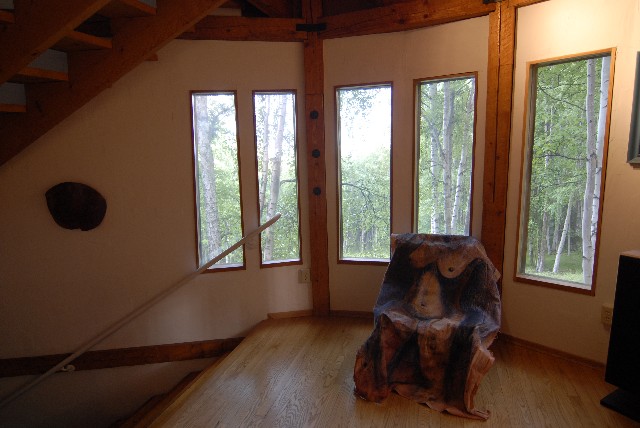
During this time, a few semesters at the University of Alaska in Fairbanks taught me that I would rather build houses than go outside to architecture school. Library self-study of Architecture led me to hyperbolic parabaloids or saddle shaped curves. I learned that these structural shapes were generated by straight lines and so could be easily framed with straight lumber. I saw infinite possibilities of combining these shapes into curved volumes that would be great to live in and most importantly, not boxes. I was aware of the architect/builder or art/craft dichotomy but didn't give a hoot and saw no reason why houses should not be sculptural. ■
-
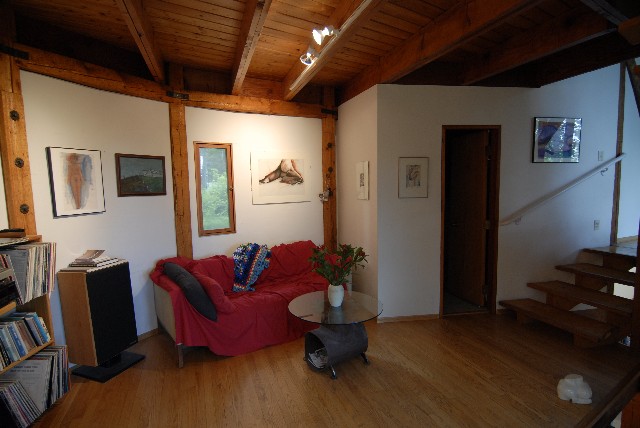
So armed with a little work experience and education I was ready to change the Alaskan living experience, at least for me, and decided to build a timber framed house. I would build a series of local white spruce frames each gradually changing shape like boat building. ■
-
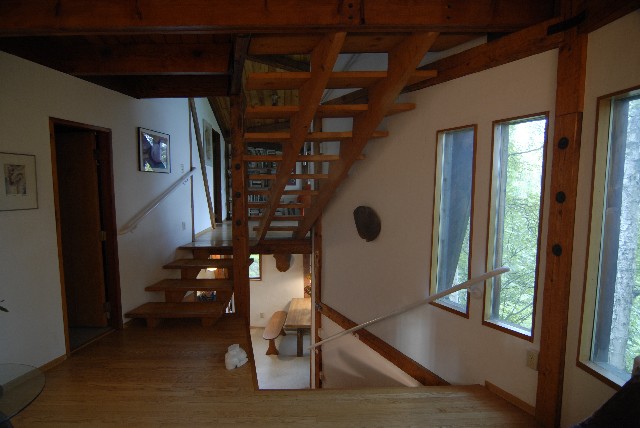
I told everyone that my buildings were curved because I didn't know how to build straight and also because of the curved and crooked lumber that we were forced to use by being at the very end of a long supply line. The truth was that these wild curved shapes were relatively easily defined with timber frames. The trick, I was to learn, was in their covering, insulating and finishing. My notion was that I could build a timber frame and then somehow later figure out a way for it to be enclosed and finished. Building out of pocket guaranteed plenty of time for the somehow later part. ■
-
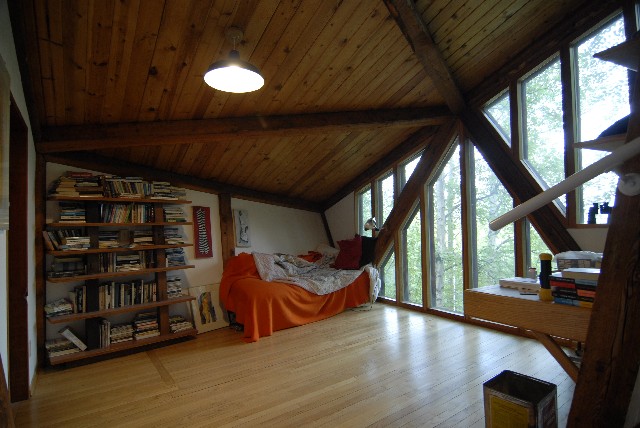
Without an architecture school background my house design parameters were few. I thought it was important for them to be warm and dry, have flat floors and enough headroom to not have to duck. I also thought that houses were only temporary additions to the wild landscape and as such should be secondary and nearly invisible. ■
-
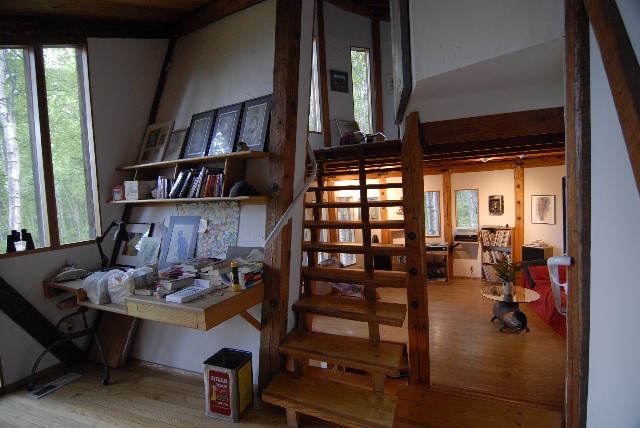
This house shape was a product of pencil, paper and maybe a wire frame maquette or two. Not having an adult around to explain its difficulties helped a lot. This shape can be loosely described as a hyperbolically truncated octahedron but its geometry was for the most part worked out at full scale in timber, in fact any working drawings are buried in the walls having been drawn on the available framing lumber. ■
-
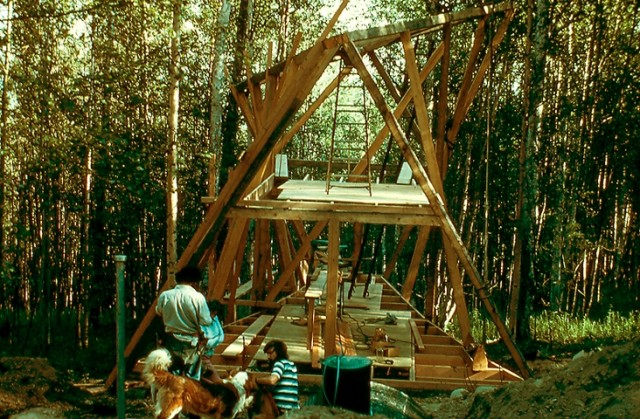
What amazes me looking back is that I thought I knew enough to start building at all. And, how much work can be accomplished by a kid standing on a ladder. ■
 Timber frame for Mark's House in 1973: a girl friend, a dog and the start of a house, a very good year. ■
Timber frame for Mark's House in 1973: a girl friend, a dog and the start of a house, a very good year. ■ Mark's House in the hills north of Fairbanks, white spruce timber frame, cedar channel siding, cedar shingles, comp roofing, 1974 ■: I was born in Fairbanks in 1947 and, I thought, grew up like most everyone else in rural America. Without a frame of reference it seemed to me that Fairbanks was a typical small town except it got a little cold in the winter. The fact that it was 375 miles to next town did make it seem a little isolated but it wasn't until I began traveling outside in the mid 60's that I realized that Fairbanks was a unique place indeed.
Mark's House in the hills north of Fairbanks, white spruce timber frame, cedar channel siding, cedar shingles, comp roofing, 1974 ■: I was born in Fairbanks in 1947 and, I thought, grew up like most everyone else in rural America. Without a frame of reference it seemed to me that Fairbanks was a typical small town except it got a little cold in the winter. The fact that it was 375 miles to next town did make it seem a little isolated but it wasn't until I began traveling outside in the mid 60's that I realized that Fairbanks was a unique place indeed. Fairbanks was surrounded by real and raw wilderness and was the perfect breeding ground for the 'man against nature' challenge. I was taught and grew to appreciate the cold and isolation and my birthplace had given me a jump start. I knew a lot about the cold and still remember how satisfying it was to dress and work comfortably at 40 below. ■
Fairbanks was surrounded by real and raw wilderness and was the perfect breeding ground for the 'man against nature' challenge. I was taught and grew to appreciate the cold and isolation and my birthplace had given me a jump start. I knew a lot about the cold and still remember how satisfying it was to dress and work comfortably at 40 below. ■ Growing up I often visited friends that lived in the hills around Fairbanks and so early on understood the winter advantages of living on a south facing hill. In addition to more sunlight, there is a winter phenomenon of temperature inversion or stratification with colder temperatures lower in the valleys and warmer higher in the hills. My friends, all children of impressively intrepid parents, lived with hauled water and outhouses, had driveways (and streets) that went unplowed in the winter. To me this lack of facility was a small price to pay for the occasional few hours of a blindingly sunny winter's day that was 20 to 40 degrees warmer than the dark and ice-foggy valley of town where I had to live. ■
Growing up I often visited friends that lived in the hills around Fairbanks and so early on understood the winter advantages of living on a south facing hill. In addition to more sunlight, there is a winter phenomenon of temperature inversion or stratification with colder temperatures lower in the valleys and warmer higher in the hills. My friends, all children of impressively intrepid parents, lived with hauled water and outhouses, had driveways (and streets) that went unplowed in the winter. To me this lack of facility was a small price to pay for the occasional few hours of a blindingly sunny winter's day that was 20 to 40 degrees warmer than the dark and ice-foggy valley of town where I had to live. ■ With the perspective of my late teens I decided that Fairbanks was a frontier town with serious climatic and economic challenges. These disadvantages had, I thought, successfully eliminated nearly all of the joy from Alaskan architecture. The owner/builders that imaginatively made do with they had to build with is another story. For everyone else it was difficult and expensive enough to build boxes. The prevailing attitude was that God himself would be happy living in one. ■
With the perspective of my late teens I decided that Fairbanks was a frontier town with serious climatic and economic challenges. These disadvantages had, I thought, successfully eliminated nearly all of the joy from Alaskan architecture. The owner/builders that imaginatively made do with they had to build with is another story. For everyone else it was difficult and expensive enough to build boxes. The prevailing attitude was that God himself would be happy living in one. ■ I of course thought this was a glaring and offensive esthetic error. Worse yet, I was convinced that my experience of living through many long dark winters in uninspired buildings had left me somehow damaged. I worried about the gene pool. ■
I of course thought this was a glaring and offensive esthetic error. Worse yet, I was convinced that my experience of living through many long dark winters in uninspired buildings had left me somehow damaged. I worried about the gene pool. ■ By my mid 20's I had worked construction for a few years, bought a chain saw and a pickup. This little bit of work experience had, of course, taught me everything I needed to know about house building in Alaska. I bought 5 acres of sweet south slope land and began by chain-sawing myself a long driveway. I was nearly ready for the challenge of correcting Alaskan architecture, and also to get out of town. ■
By my mid 20's I had worked construction for a few years, bought a chain saw and a pickup. This little bit of work experience had, of course, taught me everything I needed to know about house building in Alaska. I bought 5 acres of sweet south slope land and began by chain-sawing myself a long driveway. I was nearly ready for the challenge of correcting Alaskan architecture, and also to get out of town. ■ This was the early 70's and so a lot of my friends were also building houses in the woods. We were all pumped up with many of the same idealistic attitudes. Instead of starting careers and families we were hormone driven to build houses in the hills. ■
This was the early 70's and so a lot of my friends were also building houses in the woods. We were all pumped up with many of the same idealistic attitudes. Instead of starting careers and families we were hormone driven to build houses in the hills. ■ During this time, a few semesters at the University of Alaska in Fairbanks taught me that I would rather build houses than go outside to architecture school. Library self-study of Architecture led me to hyperbolic parabaloids or saddle shaped curves. I learned that these structural shapes were generated by straight lines and so could be easily framed with straight lumber. I saw infinite possibilities of combining these shapes into curved volumes that would be great to live in and most importantly, not boxes. I was aware of the architect/builder or art/craft dichotomy but didn't give a hoot and saw no reason why houses should not be sculptural. ■
During this time, a few semesters at the University of Alaska in Fairbanks taught me that I would rather build houses than go outside to architecture school. Library self-study of Architecture led me to hyperbolic parabaloids or saddle shaped curves. I learned that these structural shapes were generated by straight lines and so could be easily framed with straight lumber. I saw infinite possibilities of combining these shapes into curved volumes that would be great to live in and most importantly, not boxes. I was aware of the architect/builder or art/craft dichotomy but didn't give a hoot and saw no reason why houses should not be sculptural. ■ So armed with a little work experience and education I was ready to change the Alaskan living experience, at least for me, and decided to build a timber framed house. I would build a series of local white spruce frames each gradually changing shape like boat building. ■
So armed with a little work experience and education I was ready to change the Alaskan living experience, at least for me, and decided to build a timber framed house. I would build a series of local white spruce frames each gradually changing shape like boat building. ■ I told everyone that my buildings were curved because I didn't know how to build straight and also because of the curved and crooked lumber that we were forced to use by being at the very end of a long supply line. The truth was that these wild curved shapes were relatively easily defined with timber frames. The trick, I was to learn, was in their covering, insulating and finishing. My notion was that I could build a timber frame and then somehow later figure out a way for it to be enclosed and finished. Building out of pocket guaranteed plenty of time for the somehow later part. ■
I told everyone that my buildings were curved because I didn't know how to build straight and also because of the curved and crooked lumber that we were forced to use by being at the very end of a long supply line. The truth was that these wild curved shapes were relatively easily defined with timber frames. The trick, I was to learn, was in their covering, insulating and finishing. My notion was that I could build a timber frame and then somehow later figure out a way for it to be enclosed and finished. Building out of pocket guaranteed plenty of time for the somehow later part. ■ Without an architecture school background my house design parameters were few. I thought it was important for them to be warm and dry, have flat floors and enough headroom to not have to duck. I also thought that houses were only temporary additions to the wild landscape and as such should be secondary and nearly invisible. ■
Without an architecture school background my house design parameters were few. I thought it was important for them to be warm and dry, have flat floors and enough headroom to not have to duck. I also thought that houses were only temporary additions to the wild landscape and as such should be secondary and nearly invisible. ■ This house shape was a product of pencil, paper and maybe a wire frame maquette or two. Not having an adult around to explain its difficulties helped a lot. This shape can be loosely described as a hyperbolically truncated octahedron but its geometry was for the most part worked out at full scale in timber, in fact any working drawings are buried in the walls having been drawn on the available framing lumber. ■
This house shape was a product of pencil, paper and maybe a wire frame maquette or two. Not having an adult around to explain its difficulties helped a lot. This shape can be loosely described as a hyperbolically truncated octahedron but its geometry was for the most part worked out at full scale in timber, in fact any working drawings are buried in the walls having been drawn on the available framing lumber. ■ What amazes me looking back is that I thought I knew enough to start building at all. And, how much work can be accomplished by a kid standing on a ladder. ■
What amazes me looking back is that I thought I knew enough to start building at all. And, how much work can be accomplished by a kid standing on a ladder. ■
